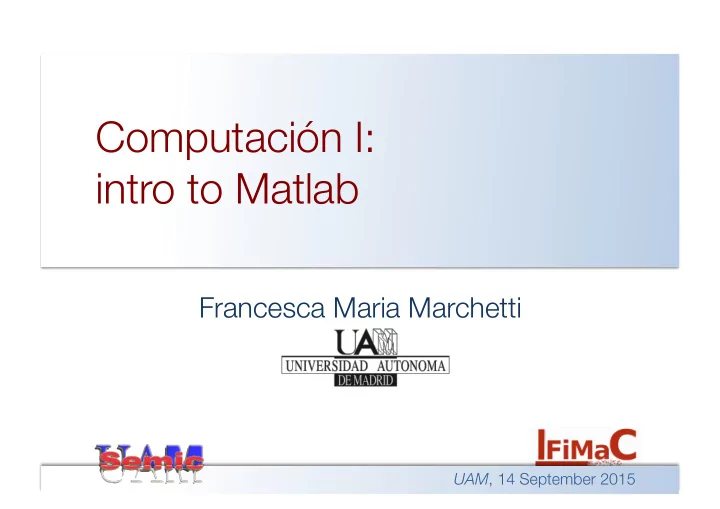

Computación I: intro to Matlab Francesca Maria Marchetti UAM , 14 September 2015
Subgroup 5165 Units 1, 2, 3, 5 (control 1) Francesca Maria Marchetti Departamento de Física Teórica de la Materia Condensada 14-Sept Facultad de Ciencias - modulo 05 till 6 th floor office 606 16 Dec tel.: 91 497 5590 e-mail: francesca.marchetti@uam.es web: http://www.uam.es/francesca.marchetti Units 4 (controls 2&3) & project Fabrice Laussy Departamento de Física Teórica de la Materia Condensada 25 Jan Facultad de Ciencias - modulo 05 till 5 th floor office 15 Apr tel.: 91 497 2665 e-mail: fabrice.laussy@gmail.com web: http://laussy.org/wiki/Fabrice Intro to Computación I
Web page http://www.uam.es/francesca.marchetti/lectures.html 1. Contacts 2. Course contents 3. Bibliography & useful links 4. Evaluation 5. Timetable & calendar 6. Complementary material: notes & handouts exercises solutions Intro to Computación I
Web page http://www.uam.es/francesca.marchetti/lectures.html Intro to Computación I
Web page http://www.uam.es/francesca.marchetti/ computacion1_15-16.html Intro to Computación I
Objectives of the course To understand how to write and use a program (in a language relevant for scientific calculations) To process, interpret, and present numerical data graphically To understand how to use computers as a tool to solve physical problems To develop the capability to model and implement a simple physical problems Public presentation of scientific results Intro to Computación I
Content Unit 1: Basic Numerical Concepts & First Applications Unit 2: Matrices, functions & Advanced Plotting/Scripting Unit 3: Linear Systems & Root Finding Unit 4: Probability, Data Analysis & Statistics Unit 5: Differential Equations, integration of Newton law Applications: Physical Systems Intro to Computación I
Unit 1 Introduction and basic concepts ⇒ introduction to MATLAB ⇒ MATLAB as a calculator (command line usage) ⇒ variables, vectors, and (in-built) functions ⇒ plotting ⇒ scripts ⇒ numerical derivatives ⇒ numerical integration Application examples: • Tiro parabolico, movimiento harmonico simple, moviemiento armonico amortiguado • Posicion, aceleracion, trayectoria, energia Intro to Computación I
Unit 2 Matrices & functions ⇒ matrix operations and representations ⇒ user-defined functions ⇒ loops: for & while ⇒ if-else conditions ⇒ representation of scalar and vector fields Application examples: • translation and rotation of vectors • discrete charge and mass distributions Intro to Computación I
Unit 3 Solving equations ⇒ linear systems ⇒ root finding Application examples: • conservation of energy • circuitos con resistencias y/o fuentes de voltaje que pueden variarse Intro to Computación I
Unit 5 Differential equations ⇒ 1 st and 2 nd ordinary differential equations ⇒ Euler method & Runge-Kutta method ⇒ systems of coupled equations Application examples: • Harmonic oscillator, friction, damping, ... • 1D equations of motion Intro to Computación I
Unit 4 Data analysis & statistics ⇒ handling of large data sets ⇒ statistical analysis of data sets ⇒ data fitting ⇒ probability distribution functions and random numbers Application examples: • your lab (Técnicas Experimentales I) data analysis! • lanzamiento de monedas, dados • caminos aleatorios • calculos de areas y volumenes Intro to Computación I
Project Physical systems Physical applications: some examples in the class, but most importantly: your very own project!!! Intro to Computación I
Content Unit 1: Basic Numerical Concepts & First Applications Unit 2: Matrices, functions & Advanced Plotting/Scripting Unit 3: Linear Systems & Root Finding Unit 4: Probability, Data Analysis & Statistics Unit 5: Differential Equations, integration of Newton law Applications: Physical Systems Intro to Computación I
Evaluation Unit 1: control #1 Basic Numerical Concepts & First Applications (common to all groups) Unit 2: 15% Matrices, functions & Advanced Plotting/Scripting 30 ¡de ¡Octubre ¡2015 ¡ Unit 3: Linear Systems & Root Finding control #2 Unit 4: (separate for each group) Probability, Data Analysis & Statistics 20% Unit 5: Differential Equations, integration of Newton law project 40% Applications: control #3 Physical Systems (common) 25% Intro to Computación I
When and where Grupo 5165 10:30-13:30 Aula: CIE3 modulo 15 4 a planta aula 403 Sala 3 (20 ordenadores) ⇒ learning by doing: essential to also work at home Intro to Computación I
Why useful? ..,i.e., why you should care....
Computation in physics • Graphic representation of trajectories Intro to Computación I
Computation in physics • Graphic representation of trajectories Intro to Computación I
Computation in physics • Graphic representation of trajectories Intro to Computación I
Computation in physics • Graphic representation of trajectories Intro to Computación I
2D and 3D plotting Intro to Computación I
2D and 3D plotting Intro to Computación I
Computation in physics • Analysis of complex functions • Zeros • Max & min • … Intro to Computación I
Computation in physics • Analysis of complex functions: energy conservation Intro to Computación I
Computation in physics • Analysis of complex functions: energy conservation Intro to Computación I
Computation in physics Numerical solutions of differential equations Mechanics (Newton) Quantum mechanics (Schrödinger) Fluidodynamics (Navier-Stokes) Electrodynamics (Maxwell) … Intro to Computación I
Pendulum ⇒ Not soluble in terms of elementary functions, but you will be able to solve it numerically before the end of the course Intro to Computación I
Pendulum: small angle approximation • Analytical solution (harmonic oscillator): compare with previous results Intro to Computación I
Double pendulum Intro to Computación I
Advanced numerics Intro to Computación I
How? Intro to Computación I
Matlab MATLAB = MATrix LABoratory interactive program computation and visualization ...not a programming language array processing language tool to understand physics better very user friendly as well as powerful (1 million users in academia & industry only in 2004) Intro to Computación I
Free alternative http://www.scilab.org Intro to Computación I
Example Graphic representation of trajectories Intro to Computación I
Example Graphic representation of trajectories Intro to Computación I
Example Graphic representation of trajectories 1. Definition of a vector t in a given interval 2. Definition of the vectors x(t) and y(t) 3. Plot Intro to Computación I
Bibliography 1. http://www.mathworks 2. http://www.mathworks.es/academia/student_center/tutorials/ launchpad.html 3. http://www.maths.dundee.ac.uk/~ftp/na-reports/MatlabNotes.pdf 4. http://www.lawebdelprogramador.com/cursos/enlace.phd? idp=3338&id=132&texto=Matlab 5. http://ocw.upm.es/ingenieria-aeroespacial/aerodinamica-numerica/ contenidos/introduccion-matlab/ 6. http://www.mathworks.es/access/helpdesk/help/pdf_doc/matlab/ getstart.pdf 7. http://mat21.etsii.upm.es/ayudainf/aprendainf/Matlab70/ matlab70primero.pdf 8. http://eupt2.unizar.es/cmedrano/manual_octave.pdf 9. …and many more Built-in help!!!!! http://www.uam.es/francesca.marchetti/lectures.html Intro to Computación I
Recommend
More recommend